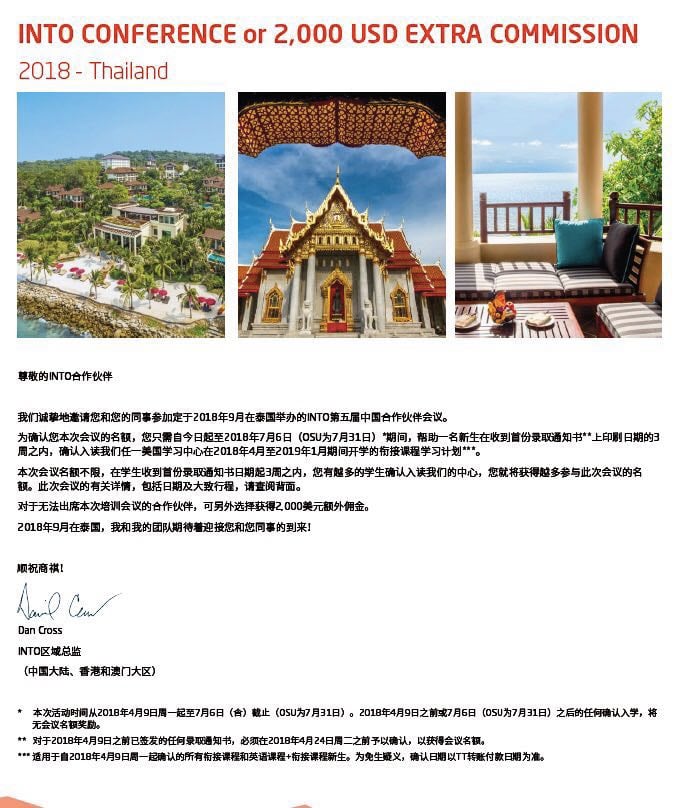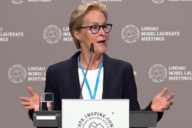You have /5 articles left.
Sign up for a free account or log in.
The growth of third-party pathway providers -- and of the private capital behind many of them -- has helped to create a more competitive and commercialized recruiting landscape.
The third-party pathway phenomenon is far from the only factor contributing to the commodification of international student recruitment, but it's among them. As the number of programs has grown and competition between corporate pathway providers has increased, some professionals in the international education field have begun raising questions about the firms' recruitment practices, in particular the payment of commissions to recruiting agents that can reach as high as $9,000 per student enrollment after bonuses are factored in.
The growth of third-party pathway programs has been entwined with growth in the adoption of commission-based agency recruitment, in which agents are paid a per capita commission for each student recruited to an institution or program. Federal law prohibits U.S. universities from paying commissions for the recruitment of domestic American students, but there is no such statutory prohibition when it comes to international students.
Third-Party Pathways: A Series
Tuesday:
- As Pathway Market Expands, Enrollment Outcomes Diverge
- The Third-Party Pathway Landscape
- A Different Pathway Model
Elsewhere Today:
After extensive debate, members of the National Association for College Admission Counseling voted in 2013 to remove a ban on commission-based international recruitment provided institutions using the practice ensure accountability, integrity and transparency. The number of institutions using international recruiting agents has grown since then. NACAC's surveys have found that 38.5 percent of institutions reported using agents in 2017, compared to 37 percent in 2015 and 30 percent in 2010.
The loosening of prohibitions and taboos on agents has freed up institutions to work with pathway providers, which generally rely on a combination of their own recruiting staff and relationships with agents who are paid on commission.
Ron Cushing, the director of international services at the University of Cincinnati, is no stranger to agent-based recruitment: his institution was an early adopter of the practice. But he said what he hears about some of the recruiting practices of the third-party pathway companies concerns him and makes it hard for institutions like his that don't have a corporate partner to compete. Cincinnati is starting a new pathway program this fall that it developed and will recruit for by itself.
“What we hear is they are paying a disproportionately high commission rate compared to what a typical school would pay,” Cushing said. “On average we pay about $2,200 a student for commission. We’re hearing in some cases $6,000, $7,000 commissions on pathway students.”
“When you’re trying to then recruit against somebody who’s paying double or triple that, it puts us at a competitive disadvantage for sure,” Cushing said. “It’s hard to compete with third-party providers that are backed by investment capital and not the actual revenue for the programs.”
“Some of it isn’t the actual commission per student, but there’s a lot of incentives being offered out there,” Cushing continued. “Some of the things we hear -- from trips to beach resorts to iPads to direct cash bonuses -- that’s concerning. Those kinds of things lend to the concern that NACAC and a lot of institutions had when this whole agent thing started. Which is -- are these agencies going to be pushing students to the right academic fit or are they going to be pushing them where they’re getting the right benefit? Obviously we have no way of knowing if that’s really happening. My hope is that it’s not, but from a perception standpoint that becomes a concern and a consideration when there is a pretty substantial gap in what people are paying.”
Commissions and Incentives
As Cushing suggested, when it comes to agent compensation, it is not just a matter of the base commission rate but other bonus incentives as well.
 Fliers and emails seen by Inside Higher Ed detail some of the promotional bonuses available to agents, including limited-time bonuses of $1,000 or $2,000 for each new student enrollment at a particular partner university or group of partner universities.
Fliers and emails seen by Inside Higher Ed detail some of the promotional bonuses available to agents, including limited-time bonuses of $1,000 or $2,000 for each new student enrollment at a particular partner university or group of partner universities.
A Chinese-language flyer from INTO invites agent partners to attend the company's Chinese Partners Conference in Thailand upon confirmed enrollment of one new pathway student; agents unable to participate can elect to receive an extra $2,000 in commission instead.
INTO confirmed that the Thailand flier, at left, “is part of an incentive and awards program offered to Chinese education counselors who meet recruitment targets on behalf of our partners. To be clear, the trip to Thailand is to participate in an annual partner development program which INTO hosts throughout the region to promote a better understanding and awareness of the multiple international study options open to talented students from across China.
“Thailand is a major regional business hub in East Asia -- directly accessible from most cities in China and the United States,” the statement continued. ”The program itself is a training event, ensuring counselors have the most up to date and appropriate information about major US study destinations which they in turn will use to provide up to date and accurate guidance to their clients and their families.”
Asked about their commission and bonus structures, the companies tend to be tight-lipped, viewing their incentive structures as proprietary. Inside Higher Ed asked representatives of pathway providers to share data on commissions. Most -- INTO, Navitas and Study Group -- declined to disclose their commission rates.
Tom Dretler, the CEO of Shorelight, said what the company pays agents is “what everybody pays in the industry.” A spokesman for the company said its commission practices are "in line" with the industry norm of 10 to 15 percent of first-year tuition. A list of Shorelight commissions and other agent communications seen by Inside Higher Ed shows that this is technically true, at least for credit-bearing programs: Shorelight's commission rate is set at 15 percent for pathway or direct entry recruitment, and 20 percent for intensive English programs.
However, the promotional bonus programs can push the agent compensation well north of the 15 percent threshold. Documents viewed by Inside Higher Ed show, for example, that after a $1,000 bonus, an agent could earn around $9,000 for sending a single student to a three-semester Shorelight pathway program at American University; by comparison, 15 percent of the $53,675 tuition would be closer to $8,000. Shorelight is also offering an extra $2,000 bonus for new fall undergraduate enrollments at Louisiana State University and the University of Kansas, two institutions that have reported lower-than-expected enrollments in their programs.
To be sure, pathway programs aren't the only entities paying bonuses to agents over and above commissions: a recent survey conducted by the American International Recruitment Council and the marketing and recruiting company Intead found that more than a quarter (26 percent) of the 163 institutions that responded to the survey said they pay a bonus to agents that exceed enrollment targets.
And it's worth noting that pathway companies aren't competing with universities only in terms of commissions or bonuses: they also compete in terms of the number of in-country recruitment staff they have and the service and outreach those staff members can provide to agents. Few individual institutions have significant numbers of in-country recruitment staff, if any.
Dretler said Shorelight has a 175-person recruiting staff. "We have a team, and that team is going direct and representing our universities. We work with agencies, too, and we’ll always work with agencies. We find that a lot of agencies do really important work. Increasingly, we find that agencies do not determine where the student goes to school because the student has more information walking in," Dretler said.
“We’re not going to talk about specific rates of commission,” said John Latham, the CEO of INTO. “But what I can say is that people have got to understand that for the student who's thinking about coming to the U.S., agents and counselors pay an absolutely invaluable role in helping them to work out how to make the best decisions.”
“The ultimate arbiter of all of this is the students,” added Tim O’Brien, INTO’s vice president for global partner development. O’Brien said a survey of 1,800 students at its U.S. pathway programs this spring found that 90 percent were satisfied, over all. Ninety-one percent were satisfied with their learning experience, and 95 percent with student support.
O'Brien added that for 2016-17, the last full year for which data were available, the average cumulative GPA for students who completed pathway programs is 3.11 at the undergraduate level and 3.52 at the graduate level.
“If the students are speaking, then they are speaking positively about their experiences with us and their partner universities. It sort of indicates that things must be OK -- better than OK from their perspective, and when you look at their progression rates and GPA that they achieve,” O’Brien said.
Yet even in the event that 90-plus percent of students in INTO programs are satisfied with their programs, the fine print suggests there are few good options for those students who might be steered wrong -- or who might, for whatever reason, show up on the first day of classes and find the program to be a poor fit. Here's an example of where the for-profit and nonprofit cultures can clash: whereas it’s typical for universities to have progressive refund schemes, in which students are eligible for a certain percentage refund of their tuition depending on how far into the semester they are, the terms and conditions for INTO programs in the U.S. typically state that fees must be paid four weeks in advance of the program start date and that no refunds of pathway program tuition or fees will be granted after that start date.
For example, the published terms of agreement for the Oregon State program state that "there will be no refund of program fees, tuition, or deposits for students who cancel, withdraw, transfer early to an OSU degree seeking program or are suspended or dismissed from any INTO Oregon State University program after the published start date."
Disruption
Third-party pathway providers pose new competition to two other types of programs or institutions that can serve as entry points for international students into U.S. higher education, including intensive English programs and community colleges.
While the number of third-party pathway programs has grown, enrollments in intensive English programs have been falling. The most substantial drops have been in the number of students coming from Saudi Arabia -- a change attributable to changes in the Saudi government's scholarship program -- but the drops are not just limited to Saudi students: a recent survey of intensive English program enrollments conducted by the Institute of International Education found that the number of intensive English students dropped for nine of the top 10 sending countries from 2016 to 2017. Over all, the number of students in intensive English programs fell by 20 percent from 2016 to 2017, following on an 18.7 percent drop the year before that.
In a recent survey of international enrollment managers conducted by a subgroup of NAFSA: Association of International Educators, some respondents identified pathway programs as disruptive forces in the field. In presenting the survey results last month at the annual NAFSA conference, David DiMaria, the associate vice provost for international education at University of Maryland, Baltimore County, said that pathway programs “are being seen almost as vacuums taking away from traditional intensive English program enrollments."
“The pathway programs are just one more challenge among many in our field,” said Patricia Juza, the past president of a consortium of university- and college-governed intensive English programs known as UCIEP and director of the International English Center at the University of Colorado Boulder. Others she cited include difficulties for students in obtaining visas, the political climate, the strength of the dollar, the collapse of oil prices, and mass shootings in the U.S.
Juza is skeptical of the third-party pathway model. "It's important to keep an open mind, but I think as an educator there are certain values that we hold: transparency, what’s in the best interest of the student," she said. "I think where my skepticism lies is campuses could sometimes do a more thorough job of not only vetting individual third-party providers but do a more thorough job of evaluating whether it’s valuable to have a third party on a campus."
Ross Jennings, the senior director of international education at Green River College, a Seattle-area community college that has been actively involved in recruiting international students for many years, said pathway programs also pose serious competition for community colleges looking to recruit international students.
Jennings said the third-party pathway programs are especially attractive options in China, where rankings are hugely important and where, Jennings said, the lower cost of community colleges can be seen as a minus because cheaper means lower quality in many parents’ minds. Pathways are attractive for that segment of students who need extra help before they can secure admission in a university of their choice -- the kinds of students a community college might otherwise attract -- but who also have the ability to pay higher tuition rates, and who presumably don't mind paying a premium for the kind of hand-holding and extra support services they get with the third-party pathway programs.
Jennings said Green River has a track record of helping students transfer after two years into top 50 or top 100-ranked universities. Generally speaking -- and with a couple notable exceptions -- universities with rankings in this elite range generally don’t have third-party pathway programs. They don’t need them: they attract plenty of international students on their own by virtue of their ranking and reputation.
But Jennings said it’s hard for a community college with its 2+2 proposition to compete against the proposition pathways offer: conditional admission via a pathway program into a solid university -- what he calls a “midmajor” -- with a national ranking in the 100 to 200 range, as in the case of an Auburn University (No. 103 in the U.S. News ranking of national universities) or an Oregon State (No. 145).
“To get a student into the midmajor [university] and having a letter from midmajor in hand, and the agents get paid three times or more in commission than we can pay; because we have a low tuition, we don’t have the funding base to pay more commission than that -- it’s very compelling,” Jennings said.
‘The Great Unknowns’
As competition for students is increasing, and the total pie of international students coming to the U.S. is not -- at least for the moment -- growing, is the space getting toward saturation? Will increasing difficulties in recruiting international students push yet more colleges toward corporate pathway partners, or will declining enrollments lead some institutions to decide they might do better going it alone and keeping what tuition revenue they earn to themselves?
"From the institutional side, there is clearly an effect of 'what’s the alternative?' That’s the question, really, to answer if the pressure is on enrollment and there are no resources to build capacity quickly," said Rahul Choudaha, the author of a two-part report on pathway programs commissioned by NAFSA. "If an institution doesn’t have enough cachet, but still wants to have a quick ramp-up of international students, then they will need something like this that will reach out to that segment of students who need help but also have the ability to pay."
Choudaha said the downsides of the corporate model are what he descried as "the great unknowns," including questions about demand. “The majority of the models are tied to one or two source countries," he said, in reference to China and Saudi Arabia. "What’s the next source country that has the ability to pay and the need for these kinds of services?"
"The changes which are happening in the political climate are affecting everyone barring the top few, and now pathways are not immune to it," Choudaha added. "The financial models were based on a rapid ramp-up. Now factoring in these risks of the external changes or even the changes in the competitive environment -- the number of players coming in and at what pace -- all those risks need to be factored in. They are the great unknowns, which can completely throw off a very long-term partnership that is expected to play out over 10 years or so."
Ian Little, the owner of CDB Solutions, a company that consults with colleges on international recruitment and other areas, said that he would recommend institutions considering a partnership with a third-party pathway provider ask questions like whether they will have access to the company's contracts with other partner institutions and whether there are incentives to drive students to any one institution over another. And at least some institutions, he suggested, would be better off investing in recruiting infrastructure on the front end rather than partnering with pathway providers for immediate access to their recruitment resources in exchange for a cut of tuition revenue on the back end.
“Not for all schools, but those comprehensive, doctorate, high research-activity schools, I believe they have the resources to do this successfully without compromising their ability to see returns immediately,” Little said. “Especially now if you’ve signed a contract recently during this period of contraction, depending on what the clauses in those contracts look like, you might not be able to go back on that or examine that for another three to five years -- and a lot can happen.”
"The pool arguably is on a downward slope and there really isn’t reason to believe that the pool will get larger or the competition will minimize," Little continued. "China has been a sustaining driver of this area, but who knows how that’s going to go. As Canada enters this game, with regional competition in Asia, with more English language programs … a shrinking pool and more competition isn’t the best formula."
“The biggest market for pathways in the last few years has been China," said Alexandra Zilovic, executive vice president of global operations and business affairs for the intensive English provider ELS Educational Services, which announced its first two pathway programs this spring, at California Lutheran University and the University of St. Thomas in Minnesota.
"What I would say about China, the pie hasn’t shrunk, but it hasn’t grown, and there’s so much competition that the pie is being sliced into smaller slices," Zilovic said. "I think at one point regarding the China market there will be saturation, and I don’t think there will be sufficient demand for dozens and dozens of new pathways to be opening up. Yet nevertheless there are new markets that are being developed. Africa is emerging as a very, very interesting market; certain countries in Africa, specifically, that have shown great interest, and we expect fully that this will be a growing market. Latin America as well."
Leaders of some of the major pathway companies say they see ample room to grow. International enrollments can go up and down in various countries, and just because they're down in the U.S. for now doesn't necessarily mean they'll be down for long.
“I think you have to think about that question [of saturation] in the context of where pathway is as a space in the United States relative to where it is outside of the United States,” David Leigh, the CEO of Study Group, said. “It’s still nascent compared to the two most mature markets, the U.K. and Australia. The pathway sector started in Australia and then moved to the U.K., and frankly it’s still, in terms of its size and maturity in the U.S., way behind the U.K. and Australia with huge room to grow.
“Our belief is that the macrotrends that help us understand why the U.K. and Australia have reached the sizes that they are don’t apply any less to the U.S. If anything they should apply to the U.S. in that the U.S. continues to be the No. 1 destination for international students looking to study abroad, but there haven’t historically been the same level of offerings. Many students have gone via a community college route, which is not obviously a pathway but perhaps offers a small piece -- something akin to a pathway. What we believe is what you will see over the medium term is the U.S. pathway market being extremely attractive in the same way that the U.K. and Australia markets are attractive.”
"We're nowhere close to saturation," said Dretler of Shorelight. He pointed out that the proportion of international students in U.S. higher education sits at just 5 percent, whereas, by comparison, it's 15 percent in Canada, 21 percent in the United Kingdom and 24 percent in Australia (see figures from Project Atlas here). Dretler said he co-founded Shorelight in 2013 in response to a finding that U.S. colleges had capacity for international students combined with increasing international demand, but that there was a "suboptimization" preventing them from reaching that population that private capital could help solve.
“We think that the main reason for that is that U.S. universities, even being the welcoming, wonderful places that they are, have unintentionally shut out the market by really only being able to market to one kind of student, and that’s the student who doesn’t need support with language and culture,” Dretler said. “Our target student is a highly motivated, talented student who does need support with language and culture -- and then we meet them with a program.”




